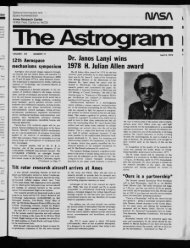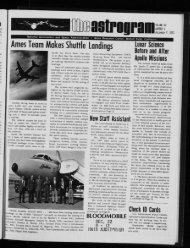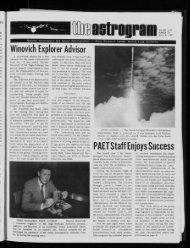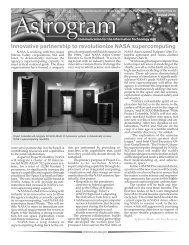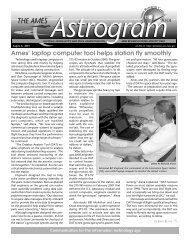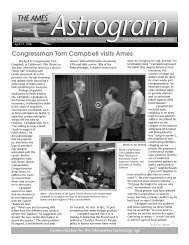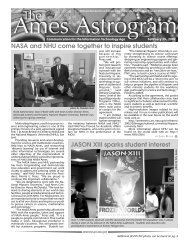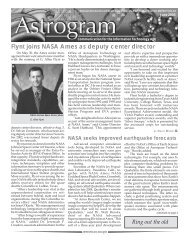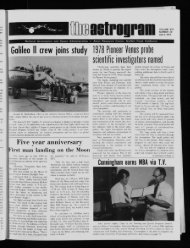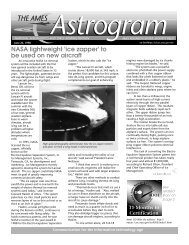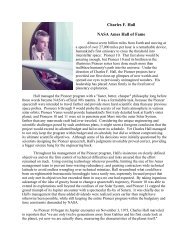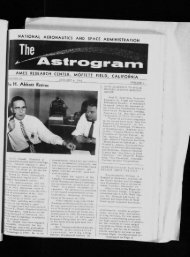Ames researchers capture aerospace spotlight/awards
Ames researchers capture aerospace spotlight/awards
Ames researchers capture aerospace spotlight/awards
Create successful ePaper yourself
Turn your PDF publications into a flip-book with our unique Google optimized e-Paper software.
Recognition & Research<br />
2001 Galileo scholarship winners announced<br />
Winners of the Galileo memorial scholarship<br />
for 2001 were announced at a banquet<br />
dinner at the Wyndham Garden Hotel<br />
in Sunnyvale on May 17. This year’s scholarship<br />
recipients are: Jesse Alejandro and<br />
Ivana Chang from San José, Gregory Donaker<br />
from Berkeley, Tammy Ma from Fremont<br />
and Saini Swati from Tracy. They are all<br />
among the top students from their respective<br />
high schools. All are accomplished<br />
athletes and musicians, and are heading to<br />
prestigious universities throughout the country<br />
to study science and engineering.<br />
Tammy Ma and Gregory Donaker each<br />
received a scholarship valued at $1,750. All<br />
other recipients were presented with $1,000<br />
<strong>awards</strong>. Each student was also given a scholarship<br />
certificate at the <strong>awards</strong> banquet.<br />
In addition to the awarding of the Galileo<br />
scholarships, world-class aerobatics champion<br />
Cecilia Aragon gave a fantastic presentation<br />
entitled, “From Fear of Flying to the<br />
World Aerobatic Championships.” During<br />
her presentation, Aragon showed some<br />
amazing video footage of her piloting skills,<br />
and encouraged everyone to take on those<br />
challenges that may initially frighten them.<br />
The Galileo memorial scholarship was<br />
established in 1973 by <strong>Ames</strong> and the San<br />
Francisco Section of<br />
the American Institute<br />
of Aeronautics<br />
and Astronautics<br />
(AIAA) to commemorate<br />
the crew who<br />
perished in the<br />
Galileo I aircraft accident<br />
on April 12,<br />
1973.<br />
The Galileo I was<br />
a Convair 990, operated<br />
by <strong>Ames</strong> as an<br />
airborne laboratory<br />
for research in aeronautics,<br />
astronautics,<br />
astronomy and Earth<br />
observations.<br />
The scholarship<br />
program is supported<br />
through donations.<br />
Residents of the Bay Area and children of<br />
<strong>Ames</strong> civil service employees, retirees and<br />
on-site contractors are eligible to apply for<br />
the scholarships. The scholarship recipients<br />
were selected from a pool of 158<br />
applicants.<br />
Administrative management of the<br />
scholarship program is provided by <strong>Ames</strong>’<br />
photo by Corwin Lakin, AIAA San Francisco Section<br />
Matt Jardin, AIAA SF chairman (far left), with 2001 Galileo memorial<br />
scholarship winners, left to right, Jesse Alejandro, Ivana Chang, Swati<br />
Saini, Tammy Ma and Gregory Donaker. Jack Boyd, executive assistant<br />
to the <strong>Ames</strong> Director, is shown far right.<br />
<strong>Ames</strong> <strong>researchers</strong> propose Mars scout projects<br />
Recently, six <strong>Ames</strong> <strong>researchers</strong> traveled<br />
to the 2001 Mars Scout mission concepts<br />
workshop in Pasadena to present their innovative<br />
ideas for 'faster, better, cheaper'<br />
ways to explore the red planet.<br />
A NASA review board is currently considering<br />
the more than 40 proposals offered<br />
by workshop participants from NASA centers,<br />
academia and industry.<br />
Mars Scout missions are a new class of<br />
focused, high-priority, experiment-based<br />
missions that can be flown for less than<br />
$300 million each. Scout missions are part<br />
of NASA's restructured Mars exploration<br />
program. The first Mars Scout mission will<br />
depart Earth as early as mid-2007. The<br />
proposed missions are based on the concept<br />
of using decentralized, competing<br />
NASA and non-NASA teams led by their<br />
principal investigators.<br />
The <strong>Ames</strong> proposals included:<br />
• Dr. Chris McKay discussed the AMEBA<br />
(Autonomous Mars Environmental and Biological<br />
Assay) concept. This project will use<br />
the already built 2001 Mars Lander. It proposes<br />
an <strong>Ames</strong>-led mission for Mars Scout<br />
to fly in 2007, with McKay serving as Principal<br />
Investigator (PI). The most innovative<br />
aspect of the proposal is a plant growth<br />
module (PGM) which will be mounted atop<br />
the lander and hold 10 varieties of a genetically-engineered<br />
mustard plant called<br />
Arabidopsous Thalania. The PGM will address<br />
key science questions about the nature<br />
of the Martian soil and the possibility of<br />
establishing future greenhouses on Mars.<br />
• Dr. Robert Haberle presented the Pascal<br />
project, a concept based on setting up a<br />
global network of 24 weather stations on<br />
Mars. Each weather<br />
station will make an<br />
hourly measurement<br />
of pressure, temperature,<br />
optical depth,<br />
and humidity for 10<br />
Mars years (more than<br />
18.8 Earth years). The<br />
most innovative aspect<br />
of the Pascal mission<br />
proposal is its<br />
unique entry probe,<br />
designed by Marc<br />
Murbach, Code SF.<br />
The probe is small,<br />
light, and self-stabilizing<br />
and could be used<br />
in future missions to<br />
deliver other payloads<br />
to Mars' surface.<br />
• Dr. Michael Sims<br />
proposed Long Day's<br />
Drive--a Rover on<br />
Mars operating during<br />
a period of sustained light.<br />
• Marc Murbach proposed Aeolus, a<br />
high-precision Scout mission concept. This<br />
mission proposes to investigate aqueous<br />
environments on Mars that are otherwise<br />
inaccessible, determine their local mineralogy<br />
and geology, and conduct soil chemistry<br />
experiments and optical imagery interpretations<br />
at each site.<br />
•Dr. Larry Lemke. together with Dr.<br />
Ronald Greeley of Arizona State (ASU),<br />
presented the Airplane for Mars Exploration<br />
(AME), with Lemke to serve as mission<br />
manager and Greeley as PI.<br />
•Dr. Butler Hine, standing in for Dr.<br />
Anita Borger of Code A. Additional scholarship<br />
review support is provided by<br />
Antoinette Price of Code D; Sidney Sun, of<br />
Code SL; Gano Chatterji, Raytheon, of Code<br />
AFC; the author in Code AFC, and members<br />
of the AIAA San Francisco Section Council.<br />
BY MATT JARDIN<br />
Image of the Autonomous Mars Environmental and Biological Assay<br />
(AMEBA), an <strong>Ames</strong>-led proposal for a Mars Scout mission in 2007.<br />
Several <strong>Ames</strong> <strong>researchers</strong> presented their innovative ideas for Mars<br />
exploration at a recent workshop in Pasadena.<br />
Steven Zornetzer, presented the proposal<br />
called Bio-Inspired Engineering of Exploration<br />
Systems (or BEES). The concept consists<br />
of micro-flyers the size of a human<br />
hand. The micro-flyers, would be launched<br />
from a Mars lander by catapult across the<br />
red planet's surface and perform aerial surveys<br />
enabling them to target and land at a<br />
particular landing site. The micro-flyers'<br />
design will enable them to use sensors and<br />
navigation techniques based on a bumblebees'<br />
flight.<br />
Six to ten of the 40 Scout proposals will<br />
be funded for further study.<br />
BY KATHLEEN BURTON<br />
2 — The <strong>Ames</strong> Astrogram June 11, 2001



